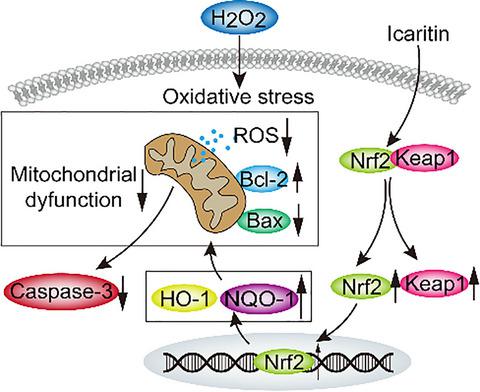当前位置:
X-MOL 学术
›
Chem. Bio. Drug Des.
›
论文详情
Our official English website, www.x-mol.net, welcomes your
feedback! (Note: you will need to create a separate account there.)
Icaritin activates Nrf2/Keap1 signaling to protect neuronal cells from oxidative stress.
Chemical Biology & Drug Design ( IF 3.2 ) Pub Date : 2020-07-11 , DOI: 10.1111/cbdd.13765 Yuyu Xu 1, 2, 3 , Xiaoyan Lu 1, 2, 3 , Li Zhang 1, 3 , Lijuan Wang 1, 2, 3 , Guimin Zhang 1, 2, 3 , Jingchun Yao 1, 2, 3 , Chenghong Sun 1, 2, 3
Chemical Biology & Drug Design ( IF 3.2 ) Pub Date : 2020-07-11 , DOI: 10.1111/cbdd.13765 Yuyu Xu 1, 2, 3 , Xiaoyan Lu 1, 2, 3 , Li Zhang 1, 3 , Lijuan Wang 1, 2, 3 , Guimin Zhang 1, 2, 3 , Jingchun Yao 1, 2, 3 , Chenghong Sun 1, 2, 3
Affiliation

|
Our earlier study indicated that icaritin (ICT) protected mice from cerebral ischemic injury by inhibiting oxidative stress, and this study aimed to investigate its mechanism using a H2O2‐treated SH‐SY5Y cells model. Cell viability was assessed by cell counting kit 8 (CCK‐8). Oxidative stress parameters were detected by flow cytometry, and signaling pathways were analyzed by immunoblotting. We found that ICT alleviated apoptosis and intracellular and mitochondrial reactive oxygen species (ROS) levels, decreased the expressions of Bax and cleaved caspase‐3, and increased the expressions of Bcl‐2 compared to H2O2 group. ICT increased mitochondrial membrane potential (ΔΨm) and blocked the opening of mitochondrial membrane permeability transporter (MPT), and increased the activity of glutathione peroxidase (GSH‐px), catalase (CAT), and superoxide dismutase (SOD), meanwhile, decreased the activity of malondialdehyde (MDA) compared to H2O2 group. Further investigation revealed that ICT significantly up‐regulated the expressions of nuclear factor erythroid 2‐related factor 2 (Nrf2), heme oxygenase 1 (HO‐1) and NAD(P)H‐quinone oxidoreductase 1 (NQO‐1). The anti‐apoptosis and antioxidative effects of ICT were blocked bay ML385, a Nrf2/Keap1 signaling pathway inhibitor. These results indicate that ICT can play a neuroprotective role against oxidative stress injury by activating Nrf2/Keap1 signaling pathway.
中文翻译:

Icaritin 激活 Nrf2/Keap1 信号以保护神经元细胞免受氧化应激。
我们早期的研究表明淫羊藿苷 (ICT) 通过抑制氧化应激保护小鼠免受脑缺血损伤,本研究旨在使用 H 2 O 2处理的 SH-SY5Y 细胞模型研究其机制。通过细胞计数试剂盒 8 (CCK-8) 评估细胞活力。通过流式细胞术检测氧化应激参数,并通过免疫印迹分析信号通路。我们发现与 H 2 O 2组相比,ICT 减轻了细胞凋亡和细胞内和线粒体活性氧 (ROS) 水平,降低了 Bax 和裂解的 caspase-3 的表达,并增加了 Bcl-2 的表达。ICT 增加线粒体膜电位 ( ΔΨm) 并阻断线粒体膜通透性转运蛋白 (MPT) 的开放,增加谷胱甘肽过氧化物酶 (GSH-px)、过氧化氢酶 (CAT) 和超氧化物歧化酶 (SOD) 的活性,同时降低丙二醛 (MDA) 的活性H 2 O 2组。进一步的研究表明,ICT显着上调了核因子红细胞2相关因子2(Nrf2)、血红素加氧酶1(HO-1)和NAD(P)H-醌氧化还原酶1(NQO-1)的表达。ICT 的抗细胞凋亡和抗氧化作用被阻断 bay ML385,一种 Nrf2/Keap1 信号通路抑制剂。这些结果表明 ICT 可以通过激活 Nrf2/Keap1 信号通路对氧化应激损伤发挥神经保护作用。
更新日期:2020-07-11
中文翻译:

Icaritin 激活 Nrf2/Keap1 信号以保护神经元细胞免受氧化应激。
我们早期的研究表明淫羊藿苷 (ICT) 通过抑制氧化应激保护小鼠免受脑缺血损伤,本研究旨在使用 H 2 O 2处理的 SH-SY5Y 细胞模型研究其机制。通过细胞计数试剂盒 8 (CCK-8) 评估细胞活力。通过流式细胞术检测氧化应激参数,并通过免疫印迹分析信号通路。我们发现与 H 2 O 2组相比,ICT 减轻了细胞凋亡和细胞内和线粒体活性氧 (ROS) 水平,降低了 Bax 和裂解的 caspase-3 的表达,并增加了 Bcl-2 的表达。ICT 增加线粒体膜电位 ( ΔΨm) 并阻断线粒体膜通透性转运蛋白 (MPT) 的开放,增加谷胱甘肽过氧化物酶 (GSH-px)、过氧化氢酶 (CAT) 和超氧化物歧化酶 (SOD) 的活性,同时降低丙二醛 (MDA) 的活性H 2 O 2组。进一步的研究表明,ICT显着上调了核因子红细胞2相关因子2(Nrf2)、血红素加氧酶1(HO-1)和NAD(P)H-醌氧化还原酶1(NQO-1)的表达。ICT 的抗细胞凋亡和抗氧化作用被阻断 bay ML385,一种 Nrf2/Keap1 信号通路抑制剂。这些结果表明 ICT 可以通过激活 Nrf2/Keap1 信号通路对氧化应激损伤发挥神经保护作用。











































 京公网安备 11010802027423号
京公网安备 11010802027423号